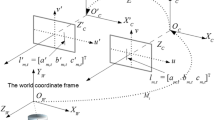Abstract
This paper discusses the basic role of the trifocal tensor in scene reconstruction from three views. This 3× 3× 3 tensor plays a role in the analysis of scenes from three views analogous to the role played by the fundamental matrix in the two-view case. In particular, the trifocal tensor may be computed by a linear algorithm from a set of 13 line correspondences in three views. It is further shown in this paper, that the trifocal tensor is essentially identical to a set of coefficients introduced by Shashua to effect point transfer in the three view case. This observation means that the 13-line algorithm may be extended to allow for the computation of the trifocal tensor given any mixture of sufficiently many line and point correspondences. From the trifocal tensor the camera matrices of the images may be computed, and the scene may be reconstructed. For unrelated uncalibrated cameras, this reconstruction will be unique up to projectivity. Thus, projective reconstruction of a set of lines and points may be carried out linearly from three views.
Similar content being viewed by others
References
Armstrong, M., Zisserman, A., and Hartley, R.I. 1996. Self-calibration from image triplets. In Computer Vision-ECCV'96, LCNS-Series, Springer Verlag, Vol 1064, pp. 3-16.
Atkinson, K.E. 1989. An Introduction to Numerical Analysis, 2nd edition. John Wiley and Sons: New York.
Beardsley, P.A., Zisserman, A., and Murray, D.W. 1994. Sequential update of projective and affine structure from motion. Report OUEL 2012/94, Oxford University (to appear in IJCV).
Faugeras, O.D. 1992. What can be seen in three dimensions with an uncalibrated stereo rig? In Computer Vision-ECCV'92, LNCS Series, Springer-Verlag, Vol. 588, pp. 563-578.
Faugeras, O. and Mourrain, B. 1995. On the geometry and algebra of the point and line correspondences between N images. In Proc. International Conference on Computer Vision, pp. 951-956.
Golub, G.H. and Van Loan, C.F. 1989. Matrix Computations, 2nd Ed. The Johns Hopkins University Press: Baltimore, London.
Hartley, R.I. 1993. Camera calibration using line correspondences. In Proc. DARPA Image Understanding Workshop, pp. 361- 366.
Hartley, R.I. 1994a. Projective reconstruction and invariants from multiple images. IEEE Trans. on Pattern Analysis and Machine Intelligence, 16:1036-1041.
Hartley, R.I. 1994b. Projective reconstruction from line correspondences. In Proc. IEEE Conf. on Computer Vision and Pattern Recognition, pp. 903-907.
Hartley, R.I. 1995. In defence of the 8-point algorithm. In Proc. International Conference on Computer Vision, pp. 1064-1070.
Hartley, R.I. and Sturm, P. 1994. Triangulation. In Proc. ARPA Image Understanding Workshop, pp. 957-966. Also in Proc. Computer Analysis of Images and Patterns, Prague, Sept. 1995, LNCS-Series, Springer Verlag, Vol. 970, pp. 190-197.
Hartley, R., Gupta, R., and Chang, T. 1992. Stereo from uncalibrated cameras. In Proc. IEEE Conf. on Computer Vision and Pattern Recognition, pp. 761-764.
Heyden, A. 1995a. Geometry and algebra of multiple projective transformations. Ph.D. thesis, Department of Mathematics, Lund University, Sweden.
Heyden, A. 1995b. Reconstruction from image sequences by means of relative depth. In Proc. International Conference on Computer Vision, pp. 1058-1063.
Heyden, A. 1995c. Reconstruction from multiple images using kinetic depths. Technical Report, ISRN LUFTD2/TFMA-95/7003-SE, Department of Mathematics, Lund University.
Horn, B.K.P. 1990. Relative orientation. International Journal of Computer Vision, 4:59-78.
Horn, B.K.P. 1991. Relative orientation revisited. Journal of the Optical Society of America, A, 8(10):1630-1638.
Longuet-Higgins, H.C. 1981. A computer algorithm for reconstructing a scene from two projections. Nature, 293:133-135.
Press, W.H., Flannery, B.P., Teukolsky, S.A., and Vetterling, W.T. 1988. Numerical Recipes in C: The Art of Scientific Computing. Cambridge University Press.
Shashua, A. 1994. Trilinearity in visual recognition by alignment. In Computer Vision-ECCV'94, LNCS-Series, Vol. 800, Springer-Verlag, Vol. I, pp. 479-484.
Shashua, A. 1995. Algebraic functions for recognition. IEEE Trans.on Pattern Analysis and Machine Intelligence, 17(8):779-789.
Shashua, A. and Werman, M. 1995. Trilinearity of three perspective views and its associated tensor. In Proc. International Conference on Computer Vision, pp. 920-925.
Shashua, A. and Anandan, P. 1996. Trilinear constraints revisited: Generalized trilinear constraints and the tensor brightness constraint. In Proc. ARPA Image Understanding Workshop, Palm Springs, pp. 815-820.
Spetsakis, M.E. 1992. A linear algorithm for point and line-based structure from motion. CVGIP: Image Understanding, 56(2):230- 241.
Spetsakis, M.E. and Aloimonos, J. 1990a. Structure from motion using line correspondences. International Journal of Computer Vision, 4(3):171-183.
Spetsakis, M.E. and Aloimonos, J. 1990b. A unified theory of structure from motion. In DARPA IU Proceedings, pp. 271- 283.
Triggs, B. 1995a. The geometry of projective reconstruction I: Matching constraints and the joint image. Unpublished report.
Triggs, B. 1995b. Matching constraints and the joint image. In Proc. International Conference on Computer Vision, pp. 338- 343.
Vieville, T. and Luong, Q.T. 1993. Motion of points and lines in the uncalibrated case. Report RR-2054, INRIA.
Weng, J., Huang, T.S., and Ahuja, N. 1992. Motion and structure from line correspondences: Closed-form solution, uniqueness and optimization. IEEE Trans. on Pattern Analysis and Machine Intelligence, 14(3):318-336.
Werman, M. and Shashua, A. 1995. The study of 3D-from-2D using elimination. In Proc. International Conference on Computer Vision, pp. 473-479.
Rights and permissions
About this article
Cite this article
Hartley, R.I. Lines and Points in Three Views and the Trifocal Tensor. International Journal of Computer Vision 22, 125–140 (1997). https://doi.org/10.1023/A:1007936012022
Issue Date:
DOI: https://doi.org/10.1023/A:1007936012022




